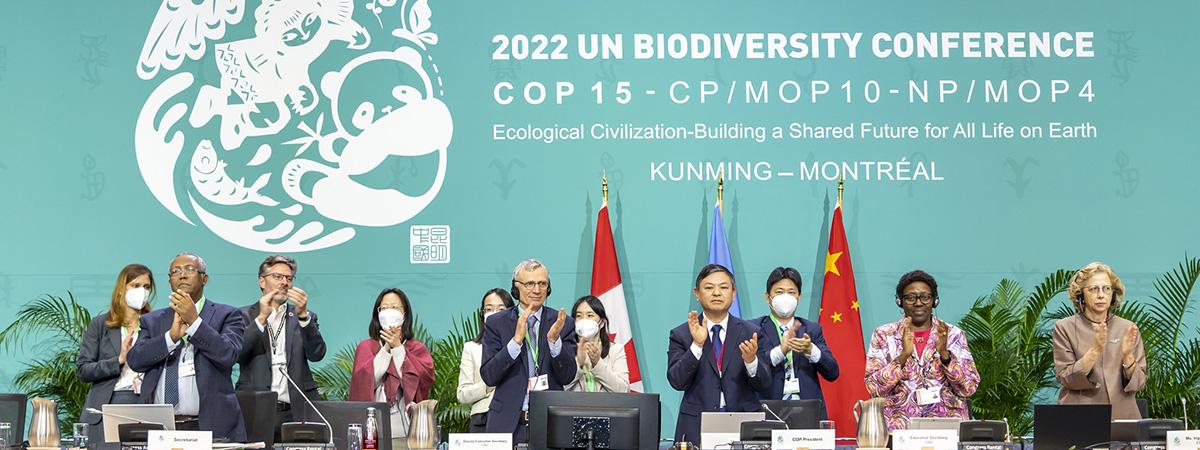Cadre mondial pour la biodiversité Kunming-Montréal

Principaux résultats adoptés lors de la COP15
Après deux semaines de négociations, 196 nations ont adopté un ensemble de mesures historiques, le cadre mondial pour la biodiversité de Kunming - Montréal. Cet accord fournira une vision stratégique et une feuille de route mondiale pour la conservation, la protection et la gestion durable de la biodiversité et des écosystèmes jusqu'en 2030.
Les 4 objectifs primordiaux et les 23 cibles comprennent des accords qui s'attaquent aux facteurs directs de la perte de biodiversité. Le paquet comprend également un cadre de suivi partiellement développé et des décisions sur l'examen de la mise en œuvre, la mobilisation des ressources, l'information sur la séquence numérique, le renforcement des capacités et le transfert de technologies.
| Cibles | Description | |
|---|---|---|
| 1 | Gestion efficace du changement d'affectation des terres et des mers, perte de zones très importantes sur le plan de la biodiversité proche de zéro d'ici à 2030 | |
| 2 | Restauration effective de 30 % des écosystèmes dégradés d'ici à 2030 | |
| 3 | Conservation et gestion efficaces de 30 % des terres et de 30 % des océans d'ici à 2030 | |
| 4 |
|
|
| 5 | Stopper les extinctions induites par l'homme et maintenir et restaurer la diversité génétique | |
| 6 | Atténuer ou éliminer l'impact des espèces exotiques envahissantes, réduire de 50 % le taux d'implantation des espèces envahissantes d'ici à 2030 | |
| 7 | Réduire les risques et les impacts de la pollution provenant de toutes les sources d'ici à 2030, réduire de moitié le risque global lié aux pesticides | |
| 8 | Minimiser les effets du changement climatique et de l'acidification des océans sur la biodiversité | |
| 9 | Garantir l'utilisation et la gestion durables des espèces sauvages, tout en protégeant l'utilisation coutumière par les populations autochtones | |
| 10 | Gestion durable des zones d'agriculture, d'aquaculture, de pêche et de sylviculture | |
| 11 | Restaurer et améliorer la fonction des écosystèmes grâce à des solutions fondées sur la nature et des approches basées sur les écosystèmes | |
| 12 | Augmenter la superficie et la qualité des espaces verts et bleus urbains | |
| 13 | Partage juste et équitable des avantages découlant de l'utilisation des ressources génétiques | |
| 14 | Intégration de la biodiversité dans les politiques et le développement dans tous les secteurs | |
| 15 | Permettre aux entreprises de contrôler, d'évaluer et de divulguer leurs impacts sur la biodiversité | |
| 16 | Encourager la consommation durable, notamment en réduisant de moitié les déchets alimentaires d'ici à 2030 | |
| 17 | Renforcer les capacités en matière de mesures de biosécurité et garantir le partage des bénéfices de la biotechnologie | |
| 18 | Supprimer progressivement ou réformer les subventions nuisibles de manière équitable, en les réduisant de 500 milliards de dollars d'ici à 2030. | |
| 19 | Augmenter considérablement les ressources financières, mobiliser 200 milliards de dollars par an d'ici à 2030, toutes sources confondues, dont 30 milliards de dollars des pays développés vers les pays en développement. | |
| 20 | Renforcer le développement des capacités et le transfert de technologies | |
| 21 | Gestion intégrée et participative, y compris l'utilisation des connaissances traditionnelles | |
| 22 | Représentation et participation équitables des peuples autochtones et des communautés locales | |
| 23 | Assurer l'égalité entre les hommes et les femmes dans la mise en œuvre du cadre |
Le libellé complet des objectifs se trouve dans le document ci joint.
La mobilisation de toutes les sources (nationales et internationales, publiques et privées) est nécessaire pour générer des ressources financières substantielles en faveur de la biodiversité. Les entreprises ont un rôle majeur à jouer dans la réalisation des objectifs, car nombre d'entre elles dépendent fortement ou modérément de la nature. Afin de réduire les risques et les impacts négatifs liés à la biodiversité, une orientation politique concrète a introduit l'obligation de surveiller, d'évaluer et de divulguer les impacts des entreprises sur la nature.
Les délégués ont également convenu d'établir au sein du GBF un fonds multilatéral pour le partage équitable des bénéfices entre les fournisseurs et les utilisateurs d'informations de séquençage numérique (DSI), qui sera finalisé lors de la COP16 en Colombie en 2024.
Un élément essentiel de la réussite du GBF est la conception d'un cadre de suivi clair et solide, qui peut guider les parties dans la mise en œuvre, l'établissement de rapports et d'évaluation. Une série d'indicateurs a été adoptée lors de la COP15, mais des travaux techniques supplémentaires sont encore nécessaires. L'accord oblige également les parties à surveiller, à examiner et à rendre compte en 2026 et 2029 de leurs progrès par rapport aux objectifs et aux cibles du cadre stratégique pour l'environnement.
